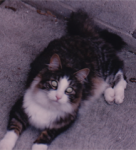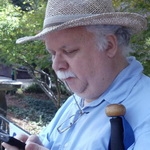CENTRALS
- littleredtree2
- Posts: 110
- Joined: Sun Nov 08, 2009 8:31 pm
- Location: The Buckeye State
CENTRALS
ok, My next question for the day.
are there different kinds of machines for Central apneas vs. Obstrutive
are there different kinds of machines for Central apneas vs. Obstrutive
''Before you criticize someone, you should walk a mile in their shoes. That way, when you criticize them, you are a mile away from them,
and you have their shoes."-- Frieda Norris
and you have their shoes."-- Frieda Norris
Re: CENTRALS
Yes, very expensive ones that I imagine would only be covered if your MD prescribed one for you, and I imagine that would only happen if you manifested a real need on your sleep study. They are called Vpap or Bi-pap machines.
- littleredtree2
- Posts: 110
- Joined: Sun Nov 08, 2009 8:31 pm
- Location: The Buckeye State
Re: CENTRALS
would mine do what ever is needed for the centrals?Julie wrote:Yes, very expensive ones that I imagine would only be covered if your MD prescribed one for you, and I imagine that would only happen if you manifested a real need on your sleep study. They are called Vpap or Bi-pap machines.
''Before you criticize someone, you should walk a mile in their shoes. That way, when you criticize them, you are a mile away from them,
and you have their shoes."-- Frieda Norris
and you have their shoes."-- Frieda Norris
- rested gal
- Posts: 12881
- Joined: Thu Sep 09, 2004 10:14 pm
- Location: Tennessee
Re: CENTRALS
Bilevel machines with "ST" (spontaneous/timed) at the end of their names used to be considered the best ones to try to treat central apneas.
But now, I believe that bilevel machines with "SV" or "ASV" at the end of their names are the best choice for treating centrals.
Your machine, littleredtree, if it's the one you've listed in your profile is a bilevel machine, but not a bilevel "ST", nor a bilevel "SV." You have a regular bilevel machine that is capable of "autotitrating."
Your BiPAP Auto cannot be set for a timed backup rate, so is not a bilevel "ST" machine. And without "SV" at the end of its name, it's not an "adapt servo ventilator" which would be the best type of machine to deal with centrals.
I'm curious though...is there a reason why you think you have a problem with central apneas that would warrant needing special treatment measures? A few centrals showing up in a sleep study wouldn't necessarily mean there is a problem with central apneas. Some centrals can be quite normal:
Links to Central Apnea discussions
viewtopic.php?p=22702
But now, I believe that bilevel machines with "SV" or "ASV" at the end of their names are the best choice for treating centrals.
Your machine, littleredtree, if it's the one you've listed in your profile is a bilevel machine, but not a bilevel "ST", nor a bilevel "SV." You have a regular bilevel machine that is capable of "autotitrating."
Your BiPAP Auto cannot be set for a timed backup rate, so is not a bilevel "ST" machine. And without "SV" at the end of its name, it's not an "adapt servo ventilator" which would be the best type of machine to deal with centrals.
I'm curious though...is there a reason why you think you have a problem with central apneas that would warrant needing special treatment measures? A few centrals showing up in a sleep study wouldn't necessarily mean there is a problem with central apneas. Some centrals can be quite normal:
Links to Central Apnea discussions
viewtopic.php?p=22702
ResMed S9 VPAP Auto (ASV)
Humidifier: Integrated + Climate Control hose
Mask: Aeiomed Headrest (deconstructed, with homemade straps
3M painters tape over mouth
ALL LINKS by rested gal:
viewtopic.php?t=17435
Humidifier: Integrated + Climate Control hose
Mask: Aeiomed Headrest (deconstructed, with homemade straps
3M painters tape over mouth
ALL LINKS by rested gal:
viewtopic.php?t=17435
Re: CENTRALS
This is a simple response but in essence OSA uses a positive airway pressure to 'stent' the airway open in order to allow regular respiration.
Stenting or holding the airway open is very effective & the normal approach to OSA. A cpap or Auto is the starting point there.
For Centrals, a different machine is needed. It not only needs to address any OSA component but to be able to detect no flow (Central) and
to then take action. The action is typically to switch between two pressures at a normal breathing rate which will usually get the user
breathing regularly again. A 'Timed Bilevel' is the starting point for addressing Centrals. The timed bit means that the machine monitors
the users rate of breathing & if that rate suddenly stops, the machine swaps between the epap (breath out) and ipap (breath in) pressure
settings until the user resumes a normal breathing rate.
It is worth noting that the Timed Bilevel can not 'force' a user to restart their breathing. That takes a specialised ventilator. A home bilevel
machine is more of an aid that works for the bulk of non critical users. The settings are important to getting the user breathing correctly as
quickly as possible. e.g. if the gap between the epap pressure & ipap pressure is too small (say 2 CMs ) then it may have no effect at all on
the user. A gap of say 4-6 CMs should be effective in most cases. Some doctors will set the gap as high as 8 CMs.
So if my timed bilevel machine is at 10 CMs for epap & 15 CMs for ipap, it should get me breathing again should I stop. Those settings are
suitable for me
Hope this helps.
DSM
#2 Just saw RG's post. RG has also mentioned some other model machines that are rated as addressing Centrals. But the principle for all
types is as described - 'Timed Mode & 2 pressures'. Also as RG mentioned if your Bilevel doesn't have a 'T' after the name (i.e. Bipap S/T
vs Bipap S) then it doesn't support Timed mode.
Stenting or holding the airway open is very effective & the normal approach to OSA. A cpap or Auto is the starting point there.
For Centrals, a different machine is needed. It not only needs to address any OSA component but to be able to detect no flow (Central) and
to then take action. The action is typically to switch between two pressures at a normal breathing rate which will usually get the user
breathing regularly again. A 'Timed Bilevel' is the starting point for addressing Centrals. The timed bit means that the machine monitors
the users rate of breathing & if that rate suddenly stops, the machine swaps between the epap (breath out) and ipap (breath in) pressure
settings until the user resumes a normal breathing rate.
It is worth noting that the Timed Bilevel can not 'force' a user to restart their breathing. That takes a specialised ventilator. A home bilevel
machine is more of an aid that works for the bulk of non critical users. The settings are important to getting the user breathing correctly as
quickly as possible. e.g. if the gap between the epap pressure & ipap pressure is too small (say 2 CMs ) then it may have no effect at all on
the user. A gap of say 4-6 CMs should be effective in most cases. Some doctors will set the gap as high as 8 CMs.
So if my timed bilevel machine is at 10 CMs for epap & 15 CMs for ipap, it should get me breathing again should I stop. Those settings are
suitable for me
Hope this helps.
DSM
#2 Just saw RG's post. RG has also mentioned some other model machines that are rated as addressing Centrals. But the principle for all
types is as described - 'Timed Mode & 2 pressures'. Also as RG mentioned if your Bilevel doesn't have a 'T' after the name (i.e. Bipap S/T
vs Bipap S) then it doesn't support Timed mode.
xPAP and Quattro std mask (plus a pad-a-cheek anti-leak strap)
- littleredtree2
- Posts: 110
- Joined: Sun Nov 08, 2009 8:31 pm
- Location: The Buckeye State
Re: CENTRALS
Rested Gal
“’I'm curious though...is there a reason why you think you have a problem with central apneas that would warrant needing special treatment measures? A few centrals showing up in a sleep study wouldn't necessarily mean there is a problem with central apneas. Some centrals can be quite normal:”
This is a paragraph from my Sleep Dr’s paper work.
“Sleep staging data: The patient was monitored from 10:18 pm to 4:45 am for a total time in bed of 387 minutes. The total sleep time was 220 minutes with a sleep efficiency of 57% . Sleep latency was 83 minutes And REM sleep was not achieved.
The patient had a fair representation of all sleep stages except REM sleep.
Respiratory event summary: CPAP was started at 4 cm and gradually increased to 8 cm. Central events emerged and therefore a BIPAP was used for titration the remainder of the study. BIPAP was started at a pressure of 8/4 cm and increased to 13/9 cm. Central events persisted at all CPAP and BIPAP pressures.
At BIPAP pressure of 10/6, the patient was monitored for a total of 41 minutes and had 2 central apneas and 7 hypopneas, With apnea hypopneas index of 18.4 per hr.”
His recommendations were…
“BIPAP at a pressure of 10/6 can be tried to treat this patient’s obstructive sleep apnea. But close clinical follow up is recommend.
If clinical symptoms fail to resolve, then consider an early titration study using adaptive servo ventilation.”
My machine is set up at 6/10? Not the 10/6 his papers mentioned?
1) I am confused to the number differences.
2) Does his info mean I might need the other kind of machine?
3) With the numbers given, should I still have centrals and hypopneas at a rate of 18.4 per hr. ?
Plus I did double check my machine info. That is the model I am using.
4) what is autotitrating?
“’I'm curious though...is there a reason why you think you have a problem with central apneas that would warrant needing special treatment measures? A few centrals showing up in a sleep study wouldn't necessarily mean there is a problem with central apneas. Some centrals can be quite normal:”
This is a paragraph from my Sleep Dr’s paper work.
“Sleep staging data: The patient was monitored from 10:18 pm to 4:45 am for a total time in bed of 387 minutes. The total sleep time was 220 minutes with a sleep efficiency of 57% . Sleep latency was 83 minutes And REM sleep was not achieved.
The patient had a fair representation of all sleep stages except REM sleep.
Respiratory event summary: CPAP was started at 4 cm and gradually increased to 8 cm. Central events emerged and therefore a BIPAP was used for titration the remainder of the study. BIPAP was started at a pressure of 8/4 cm and increased to 13/9 cm. Central events persisted at all CPAP and BIPAP pressures.
At BIPAP pressure of 10/6, the patient was monitored for a total of 41 minutes and had 2 central apneas and 7 hypopneas, With apnea hypopneas index of 18.4 per hr.”
His recommendations were…
“BIPAP at a pressure of 10/6 can be tried to treat this patient’s obstructive sleep apnea. But close clinical follow up is recommend.
If clinical symptoms fail to resolve, then consider an early titration study using adaptive servo ventilation.”
My machine is set up at 6/10? Not the 10/6 his papers mentioned?
1) I am confused to the number differences.
2) Does his info mean I might need the other kind of machine?
3) With the numbers given, should I still have centrals and hypopneas at a rate of 18.4 per hr. ?
Plus I did double check my machine info. That is the model I am using.
4) what is autotitrating?
''Before you criticize someone, you should walk a mile in their shoes. That way, when you criticize them, you are a mile away from them,
and you have their shoes."-- Frieda Norris
and you have their shoes."-- Frieda Norris
Re: CENTRALS
I was found to have complex apnea,both central and osa in August.I use a BiPAP Auto SV with Heated Humidifier machine with the following settings.Max IPAP of 30.0 and the Min IPAP of 15.0.This shows how wide of a spread they can set your machine.I am feeling great since starting my treatments.The main thing for users is to keep up with your therapy.A bad day now and than will happen but just push on for better days.
Wes
Wes
Re: CENTRALS
Wes, what epap setting did they apply on your machine ?1wacy wrote:I was found to have complex apnea,both central and osa in August.I use a BiPAP Auto SV with Heated Humidifier machine with the following settings.Max IPAP of 30.0 and the Min IPAP of 15.0.This shows how wide of a spread they can set your machine.I am feeling great since starting my treatments.The main thing for users is to keep up with your therapy.A bad day now and than will happen but just push on for better days.
Wes
Do you know what the typical nights maximum Ipap pressure is that your machine goes to ? (is on the nightly data off the datacard)
Tks DSM
PS littleredtree - am leaving your post to RestedGal as she asked you for the data & no doubt will offer very good advice.
xPAP and Quattro std mask (plus a pad-a-cheek anti-leak strap)
Re: CENTRALS
DSM
My EPAP is set at 14.As for the maximum IPAP I do go right to the top(30.0)on ocasions.When I first started therapy back in August about 1/2 of the time it went high.The longer I am in therapy the line is coming down.My average Peak IPAP is running from 18 to 20.
Wes
My EPAP is set at 14.As for the maximum IPAP I do go right to the top(30.0)on ocasions.When I first started therapy back in August about 1/2 of the time it went high.The longer I am in therapy the line is coming down.My average Peak IPAP is running from 18 to 20.
Wes
- rested gal
- Posts: 12881
- Joined: Thu Sep 09, 2004 10:14 pm
- Location: Tennessee
Re: CENTRALS
That sounds like a very good plan to me, but I'm not a doctor.littleredtree wrote:His recommendations were…
“BIPAP at a pressure of 10/6 can be tried to treat this patient’s obstructive sleep apnea. But close clinical follow up is recommend.
If clinical symptoms fail to resolve, then consider an early titration study using adaptive servo ventilation.”
IPAP can't be set for less than EPAP is set for. The machine won't allow those two pressures to be set "backwards." So I think it's safe to assume your machine is set for plain bilevel mode at IPAP 10, EPAP 6. "Bi-Flex" (a comfort feature to smooth out the transitions) may, or may not, have been turned on.littleredtree wrote:My machine is set up at 6/10? Not the 10/6 his papers mentioned? 1) I am confused to the number differences.
Yes, that's what the doctor's statements mean. But it also means that the centrals which emerged with the application of "CPAP" in the titration portion of the sleep study (and persisted when the tech switched you to bilevel in the study) might go away if your body is given time to get used to treatment. Might also mean that if you feel quite a bit better, residual centrals (if any) are not causing a problem for you.littleredtree wrote:2) Does his info mean I might need the other kind of machine?
Well, the "A" part of AHI (apnea/hypopnea index) means apneas -- which could be either kind (obstructive or central or both), so the AHI of 18.4 might not consist of just central apneas along with hypopneas. Could be obstructives and centrals, or just one or the other, along with hypopneas making up the AHI.littleredtree wrote:3) With the numbers given, should I still have centrals and hypopneas at a rate of 18.4 per hr. ?
A rose by any other name, though... no, I wouldn't want to have any kind of AHI of 18 still happening. But I'd give the treatment a chance for awhile because persisting centrals might, just might, go away during this first month of treatment. There's plenty of time down the road to think about switching to ASV if you don't begin to feel appreciably better by the end of your first month. I wish DME's would begin checking closely for leak info during the first few days of treatment, but they generally don't check anything until a month's gone by... looking for just compliance data (hours of use) at end of first month. All the more reason for us to monitor our own treatment ourselves with software, but that's a whole other story.
Thanks for checking that.littleredtree wrote:Plus I did double check my machine info. That is the model I am using.
Setting the machine for a range of pressures and letting it vary the pressure "as needed" instead of setting one fixed pressure. In the case of your BiPAP Auto, it would mean setting the machine for "auto bilevel" instead of "bilevel" mode, and would mean setting a maximum pressure that IPAP can use and a minimum pressure that EPAP can use. Letting both IPAP and EPAP vary "automatically" as needed. But, before that sounds like "Wow, then why are we not letting those two pressures autotitrate as needed?", autotitration with a non-SV machine is not a good thing to turn on if a person has "Complex Sleep Apnea."littleredtree wrote:4) what is autotitrating?
Sounds to me like your doctor is well aware of CSDB (complex sleep disordered breathing, also called CompSAS for complex sleep apnea syndrome), is well aware of treating that with adapt servo ventilator machines, and is aware of the fact that some people's bodies just need more time than is available during a titration night to get used to additional pressure, and that the emergent centrals might subside on their own with a few days/weeks of treatment at home.
Now, how they'll know the centrals have subsided is another question...
Sounds like the plan is to start out with seeing if you begin feeling better this first month. That seems reasonable to me. But like I've said many a time, I'm no doctor!!
I personally wouldn't be in a big hurry to get switched to an SV machine unless I absolutely, positively, no-question-about-it, needed that kind of machine.
ResMed S9 VPAP Auto (ASV)
Humidifier: Integrated + Climate Control hose
Mask: Aeiomed Headrest (deconstructed, with homemade straps
3M painters tape over mouth
ALL LINKS by rested gal:
viewtopic.php?t=17435
Humidifier: Integrated + Climate Control hose
Mask: Aeiomed Headrest (deconstructed, with homemade straps
3M painters tape over mouth
ALL LINKS by rested gal:
viewtopic.php?t=17435
- littleredtree2
- Posts: 110
- Joined: Sun Nov 08, 2009 8:31 pm
- Location: The Buckeye State
Re: CENTRALS
Thank you Rested Gal.
you are The best! I am giving you a score of 10
Maybe you should go into medicine. Your read on my info was easy to understand and informative.
I went to the sleep center this afternoon. I was fitted for a new mask. The FITlife mask was making a pressure point at my temples. Och!
My new mask is the COMFORT Gel. Small. I tried the QUATTRO, but even the small was to long for my short chubby face. It went up into my eyes.
Then, I asked if they would fix my machine so It showed me ALL information available. They said NO. Big surprise.
They did take my card and read it, and give me a copy. Soooo, when I get more guts to change it...in a month or so. I will then.
Was told to use it as is, for at least 1 month. Take the card in to be read. Then they will send the info to a sleep Dr.
I will call this Doctor in the am and see what HE wants me to do.
you are The best! I am giving you a score of 10

Maybe you should go into medicine. Your read on my info was easy to understand and informative.
I went to the sleep center this afternoon. I was fitted for a new mask. The FITlife mask was making a pressure point at my temples. Och!
My new mask is the COMFORT Gel. Small. I tried the QUATTRO, but even the small was to long for my short chubby face. It went up into my eyes.
Then, I asked if they would fix my machine so It showed me ALL information available. They said NO. Big surprise.
They did take my card and read it, and give me a copy. Soooo, when I get more guts to change it...in a month or so. I will then.
Was told to use it as is, for at least 1 month. Take the card in to be read. Then they will send the info to a sleep Dr.
I will call this Doctor in the am and see what HE wants me to do.
''Before you criticize someone, you should walk a mile in their shoes. That way, when you criticize them, you are a mile away from them,
and you have their shoes."-- Frieda Norris
and you have their shoes."-- Frieda Norris
- littleredtree2
- Posts: 110
- Joined: Sun Nov 08, 2009 8:31 pm
- Location: The Buckeye State
Re: CENTRALS
just one more question for this minute
What can they do if I change the machine myself? would they drop me as a customer?
I am a chicken still. Afraid to mess it up.
Will most likely have my son do it. He is a master at reading instructions. And I think he already did his. I will have to check on that.
Again, Thanks EVERYONE for helping me.
Can't wait to try my new mask tonight.

What can they do if I change the machine myself? would they drop me as a customer?
I am a chicken still. Afraid to mess it up.
Will most likely have my son do it. He is a master at reading instructions. And I think he already did his. I will have to check on that.
Again, Thanks EVERYONE for helping me.
Can't wait to try my new mask tonight.

''Before you criticize someone, you should walk a mile in their shoes. That way, when you criticize them, you are a mile away from them,
and you have their shoes."-- Frieda Norris
and you have their shoes."-- Frieda Norris
- JohnBFisher
- Posts: 3821
- Joined: Wed Oct 14, 2009 6:33 am
Re: CENTRALS
The biggest problem is that your body might not react well to increased or decreased pressure. I recently went through two sleep studies. They attempted to titrate me with a BiPAP unit (I've used one for many years, but they assumed the pressure might need to be adjusted). However, I had severe problems (as I described to my doctor) with BiPAP.littleredtree wrote:What can they do if I change the machine myself? would they drop me as a customer?
I am a chicken still. Afraid to mess it up.
So, I went through a second sleep study with a BiPAP AutoSV unit. I went from about 59 apneas (mostly central) to none! But the AutoSV unit took me quite some time to adjust to it (60 to 90 minutes). Not only does it include a track the breathing rate, but it also tracks the breathing pattern and tries to "remind" the user of their normal breathing pattern. It's an odd experience, but for me it was very comforting.
To help you understand why it mattered for me, let me provide a summary of some of my sleep issues.
I have struggled with failing to breathe as I fall asleep for many, many months now. Due to a progressive neurological problem my brainstem is not working as well as it should. As I fall asleep it fails to trigger normal breathing. That results in sudden jolts of adrenaline as my body wakes me to keep me breathing. As a result, I was getting two to four hours of sleep per night.
Generally, a BiPAP S/T (Spontaneous/Timed) unit is the next step if the central apneas are bad enough. In my case due to the progressive neurological condition, the AutoSV unit made more sense to the doctor.
As a side note, my understanding is that if you have a few central apneas (less than 20 in a night), they typically will try to minimize the issue with BiPAP. In my case on BiPAP alone, I had more than six times the number of central apneas as I did obstructive apneas.
So, some central apneas are normal. And as another person noted, with the introduction of the positive airway pressure, it can induce central apneas. Sometimes that is a fine balance - and one reason to NOT adjust the unit on your own. You could make the central apneas worse.
Hope that helps.
_________________
| Mask: Quattro™ FX Full Face CPAP Mask with Headgear |
| Additional Comments: User of xPAP therapy for over 20 yrs. Resmed & Respironics ASV units with EEP=9cm-14cm H2O; PSmin=4cm H2O; PSmax=15cm H2O; Max=25cm H2O |
"I get up. I walk. I fall down. Meanwhile, I keep dancing” from Rabbi Hillel
"I wish to paint in such a manner as if I were photographing dreams." from Zdzisław Beksiński
"I wish to paint in such a manner as if I were photographing dreams." from Zdzisław Beksiński
- littleredtree2
- Posts: 110
- Joined: Sun Nov 08, 2009 8:31 pm
- Location: The Buckeye State
Re: CENTRALS
Thanks for the great info John.
I will definetly not start doing silly things...I have a beautiful granddaughter I would love to see again.
Have to say, I have had more info, here, today. Than I had at the DME This afternoon.
have great sleep tonight.
I will definetly not start doing silly things...I have a beautiful granddaughter I would love to see again.
Have to say, I have had more info, here, today. Than I had at the DME This afternoon.
have great sleep tonight.
''Before you criticize someone, you should walk a mile in their shoes. That way, when you criticize them, you are a mile away from them,
and you have their shoes."-- Frieda Norris
and you have their shoes."-- Frieda Norris












